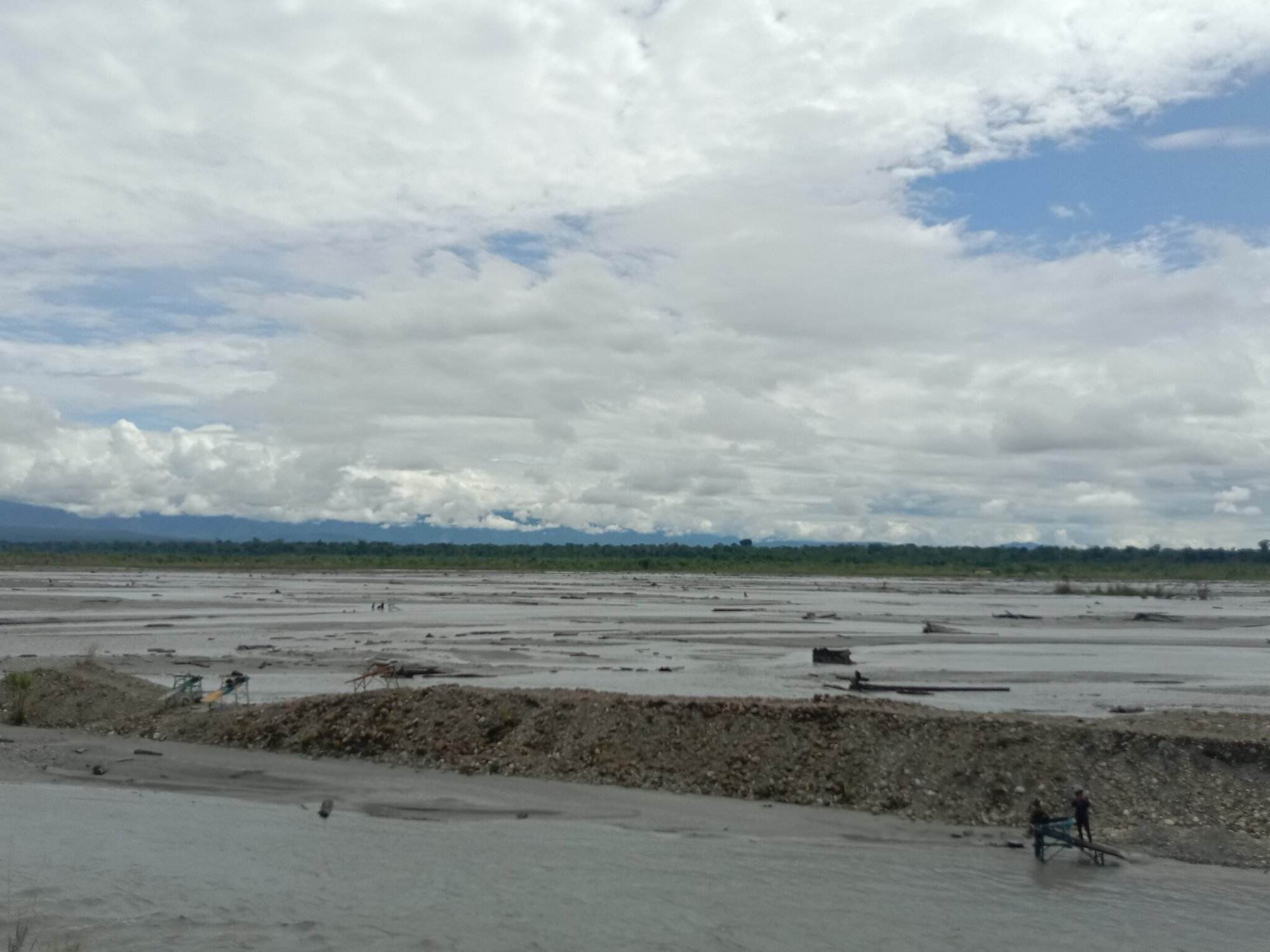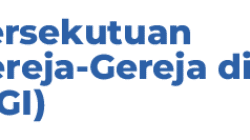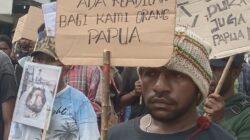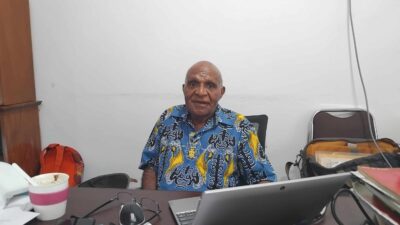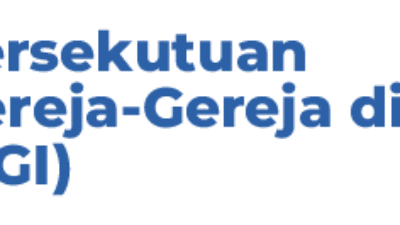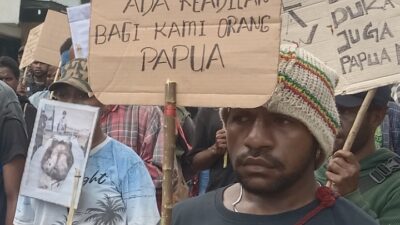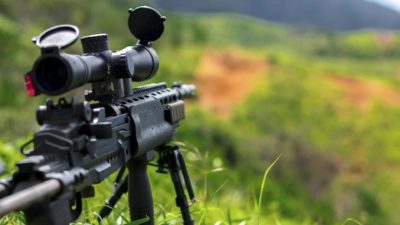Reporter: Theo Kelen, Rabin Yarangga, Dominggus A Mampioper, Angela Flassy
Timika, Jubi – Since 1972, PT Freeport Indonesia’s mining operations in Mimika, Central Papua have transformed mountains into giant ravines, pulverizing mineral-rich rocks and depositing the resulting waste, known as tailings, into rivers. While these tailings have brought fortune to many small-scale miners, they have also led to river and coastal siltation, causing problems in the region. Jubi and CNN Indonesia collaborated to shed light on the dual nature of Freeport’s tailings in a series of three reports. This is the second installment of our collaboration.
In the Far East Mimika District, Mimika Regency, Alexander Matiwera was repairing his kitchen’s roof when Jubi visited him. The age of the woven nipa leaves used in the kitchen’s roof had caused them to deteriorate over time.
Living with his family, the 51-year-old man, along with his wife, Yustina Tawapi (45), diligently weaved nipa leaves to replace the worn-out ones. Matiwera’s children skillfully prepared the ropes that would be used to secure the new leaves onto the kitchen roof. Matiwera explained that three layers were needed to ensure its strength.
Matiwera and his family resided in a house provided by the Mimika Administration in Ohotya Village, also known as Otakwa Village. The government had offered them the house after their previous one, located approximately 500 meters away, was destroyed by the waves.
“We started moving from the old village in 1999. Our old house was made of wood with gaba sago walls and a roof made of nipa leaves. The government provided assistance, and then they built zinc-roofed houses. The current house we live in was supported by the government,” Matiwera explained.
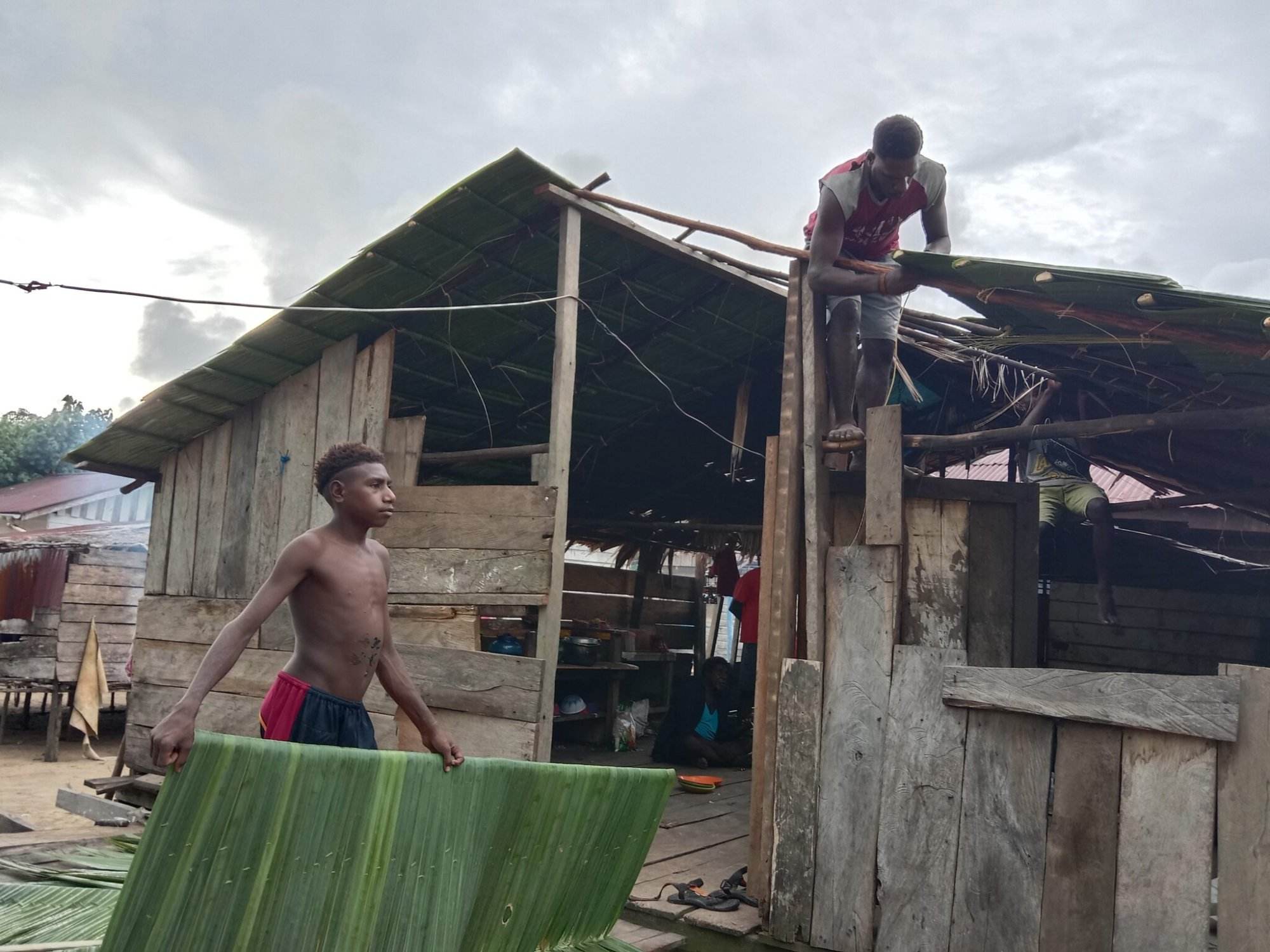
Their house, constructed on stilts with a tin roof and planks, did not originally include a kitchen. Matiwera personally built the kitchen, which he was repairing that afternoon due to the wear and tear of the nipa leaf roof.
Matiwera resides in Ohotya Village along with his wife and three children. Their eldest son, Atofianus Matiwera (21), is married and has brought his wife, Hermina Matanimi, to live with them in the same house.
While they are commonly referred to as Kamoro people, Matiwera clarifies that they originally identified themselves as members of the Sempan Tribe from the East, despite having different languages. They still consider themselves part of the Sempan East community.
Ohotya Village is situated away from the busy city life of Timika, the capital of Mimika, which revolves around the mining operations of PT Freeport Indonesia. To reach Ohotya, we traveled by car for about an hour from Timika to Pomako Port.

From Pomako Port, we continued our journey on a small boat powered by an 80 horsepower engine, navigating through river bends and mangroves for an hour until we reached the coast of Puriri. We then traveled along the shores of the Arafuru Sea, which is known for its large waves. After approximately three hours along the coast, we arrived at Ohotya.
In their daily lives, Matiwera and his family share similar experiences with other indigenous Kamoro people, who reside along the coast of Mimika and have been affected by Freeport’s mining activities.
Every morning, Matiwera must go to the rainwater reservoir in Ohotya Village to fulfill the household’s need for clean water. He wakes up at 5 a.m. and fills the water drum.
Alexander Matiwera, like many Kamoro people, rely on hunting, fishing, and gathering as their primary means of subsistence, without engaging in farming or cultivation.
When the time comes to procure food, Matiwera embarks on journeys along the coastline, spending two to three days walking and fishing in the brackish waters of the Ohotya River estuary.
“If luck is on my side, I can catch up to 150 kilograms of fish. On less fortunate days, I still manage to catch at least 10 kilograms,” he remarked.

However, Matiwera voices his growing concern about the increasing frequency of catching undernourished fish or those with average-sized bodies but small heads. According to him, this occurrence has become more prevalent since the introduction of tailings sediment from Freeport into the waters of Ohotya.
“We encounter thin fish that we neither sell nor consume. If they are large and healthy, we eat and sell them. But there are also fish with disproportionately large heads and small bodies. We wonder if pollution is the cause. It wasn’t like this before. In the past, the fish were healthy and fat,” he explained.
Matiwera shared that he typically sells the fish he catches to collectors or local businessmen who visit Ohotya Village. Thorny fish are usually priced at Rp 6,000 per kilogram, while snapper fetches Rp 17,000 per kilogram. As for crabs, their prices vary based on size, ranging from Rp 10,000 to Rp 40,000 per head.
If lucky, Matiwera can earn around Rp 2 million from the fish sales. He uses it to provide for his family’s food and support his children’s education. However, selling his catch directly at Pomako Port proves challenging due to the high travel cost of Rp 980,000 from Ohotya. Additionally, he feels anxious about the treacherous waves of the Arafuru Sea, as they pose a risk of capsizing boats traveling along the coastline.
Siltation due to tailings waste
Bernadus Irahewa, the head of Ohotya Village, expressed his concern about the impact of Freeport’s tailings sediment on the lives and livelihoods of 154 families in the village. Irahewa explained that the tailings discharged by Freeport through the Ajkwa River flow for 120 kilometers until reaching the Arafuru Sea.
Once in the open waters, the tailings sediment gets dispersed by tidal waves, leading to increased sedimentation in river mouths, including the Ohotya River. Irahewa observed that this gradual siltation process has caused a decline in the fish population, affecting the indigenous communities residing along the Mimika coast.
“The fish are disappearing. The river that used to be wide now has tailings on its surface,” he lamented.
Furthermore, Irahewa pointed out that the combination of tides and tailings sediment has had adverse effects on sago trees, which are a vital food source for the Sempan and Kamoro indigenous communities. The sago trees have been damaged and even killed as a result. When processed into sago flour, the texture becomes coarse, and the sediment takes on a blackish color with an unpleasant odor.
“Our sago trees are no longer thriving, but people still attempt to consume them. Previously, sago flour could last for a month, but now it can’t. After just a week or two, it becomes unsuitable for consumption. It doesn’t rot, but it becomes hard and emits a foul smell. We still have sago in our hamlet, but it’s not like it used to be,” he explained.
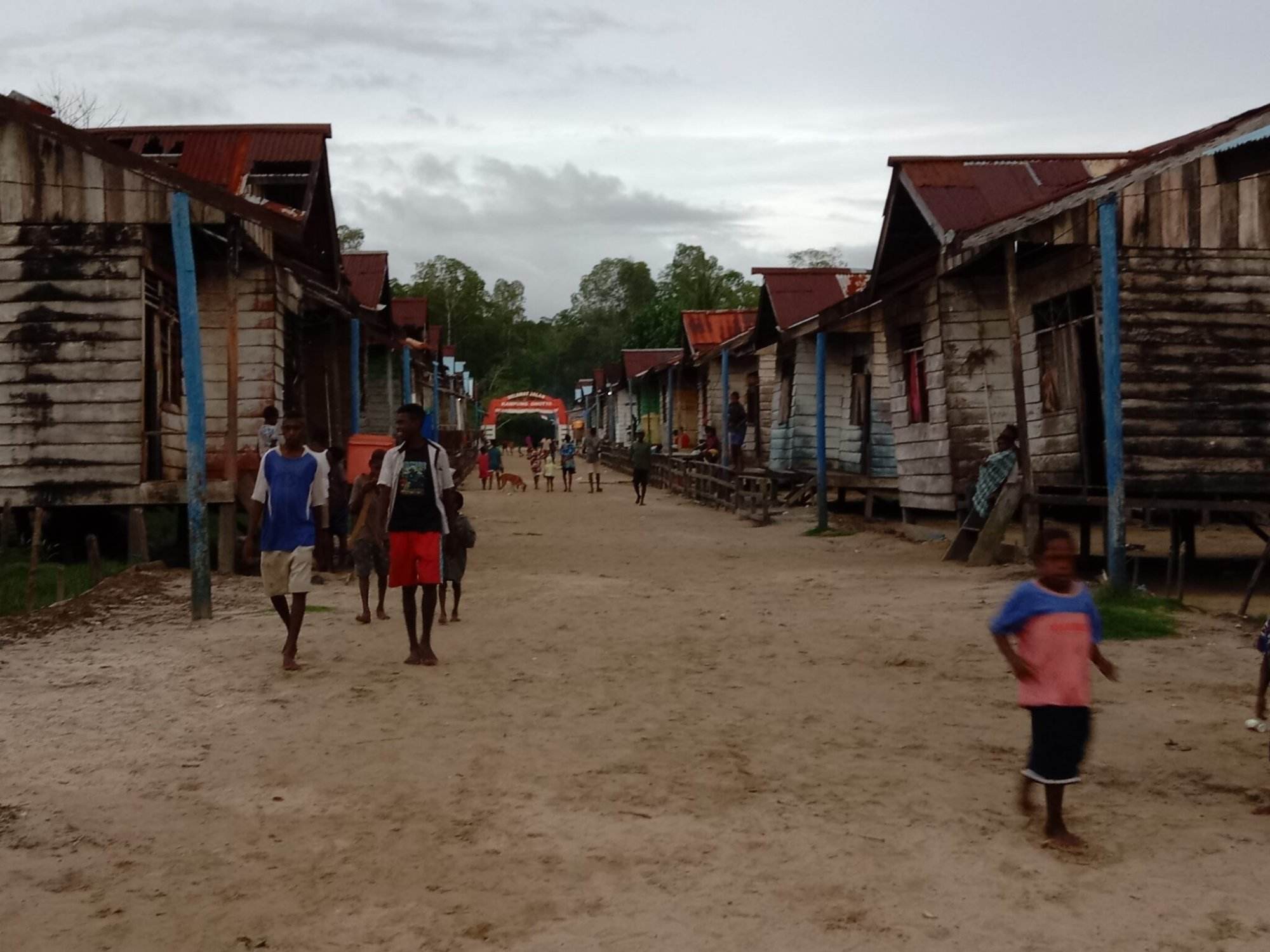
Irahewa asserted that the people of Ohotya Village derive no benefits from the presence of tailings, contrary to what some officials or individuals might claim.
“As far as we are concerned, us the people only experience harm from tailings. We are unaware of any benefits they bring. It is the government and relevant agencies that possess the knowledge and capability to process the tailings, so they should take action. All we know is that tailings bring us trouble,” he expressed.
Irahewa mentioned the difficulties faced by residents of Ohotya when traveling to Timika via Pomako Port. He explained that in the past, people could travel along the Khuhaireipey River, then proceed through the Yamawiripa River and the Yamaima River until reaching the Hafuka River. From there, they would navigate through Karaka Island and reach Pomako Port.
“However, now, if we want to travel along the coastal waters from Karaka Island to Pomako, we have to first check if the tide is low, as the tailings may resurface,” he explained.
Despite living under such threats, Irahewa highlighted that the residents of Ohotya Village choose to remain in their ancestral lands. “We cannot relocate because our village is situated on customary land passed down to us by our ancestors,” he emphasized.
Life in Ohotya is filled with challenges. Daniel Bipoaro (51) reminisces about the days when the Ohotya, Hetia, and Momoa Rivers provided the community with clear and clean water. However, since the early 1990s, the water from these rivers has become unsuitable for consumption.
“The water from the three rivers is no longer fit for use. It’s no longer clear. You can’t collect it directly from the river because it has become extremely turbid,” he explained.
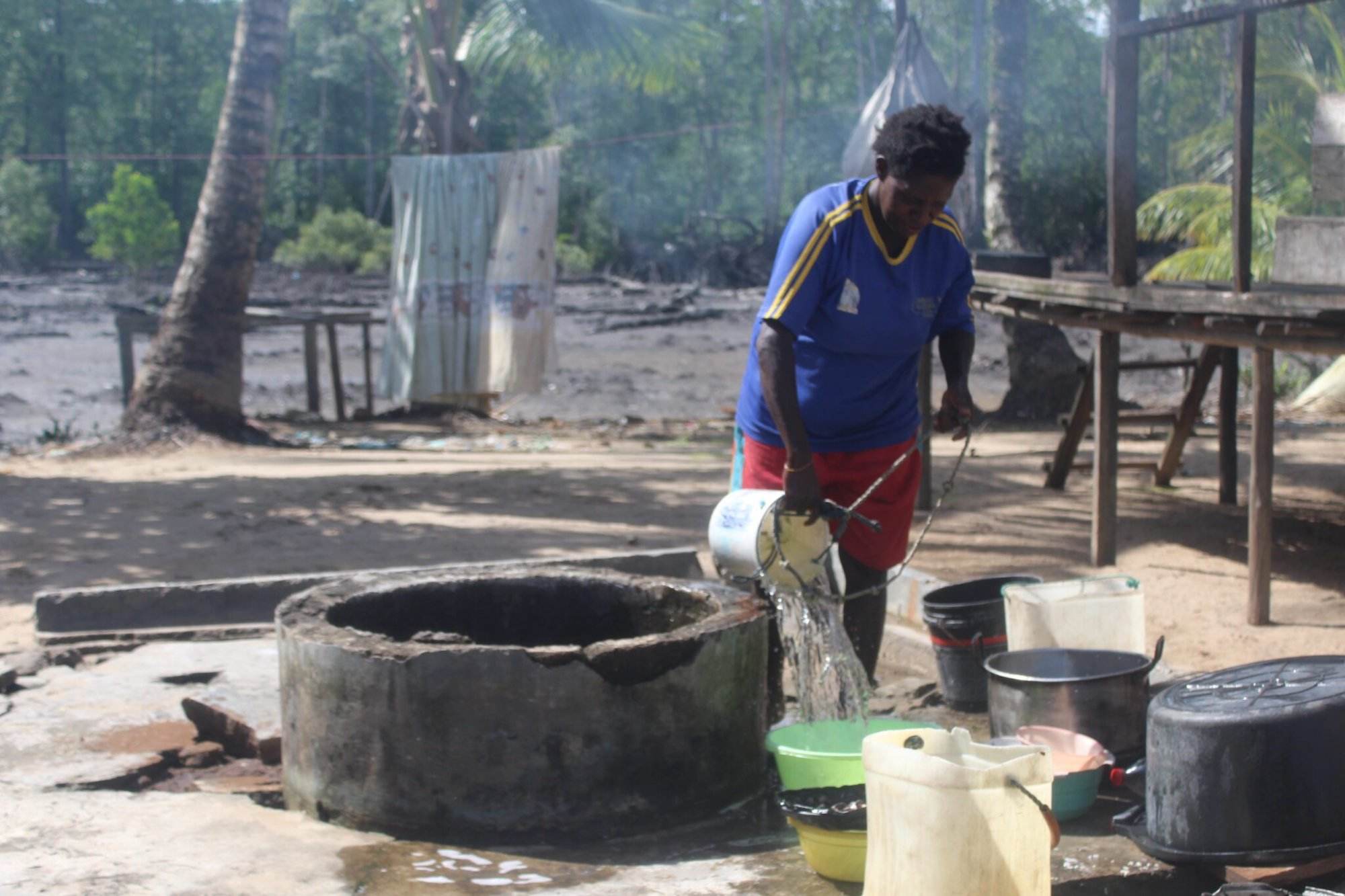
Similar to Alexander Matiwera, Bipoaro relies on rainwater for cooking and daily needs. For washing and bathing, his family uses brackish well water.
When rainwater supplies are depleted, Bipoaro and other residents of Ohotya have to travel 30 kilometers by boat to find water in the swamps and streams surrounding the Ohotya, Hetia, and Momoa Rivers.
Moreover, the water at the river estuary has become increasingly harmful to the children. Bernardus Irahewa shared that her 11-year-old daughter, Semona Irahewa, has been suffering from an itchy skin since October 2022. Semona’s face is covered in bumps, and her hands are plagued by rashes and bumps.
Periodically, Irahewa has to take her daughter to the Caritas Hospital in Settlement Unit 5 for treatment. “Sometimes the itch goes away but it keeps coming back. We seek treatment at the local health center,” he revealed.
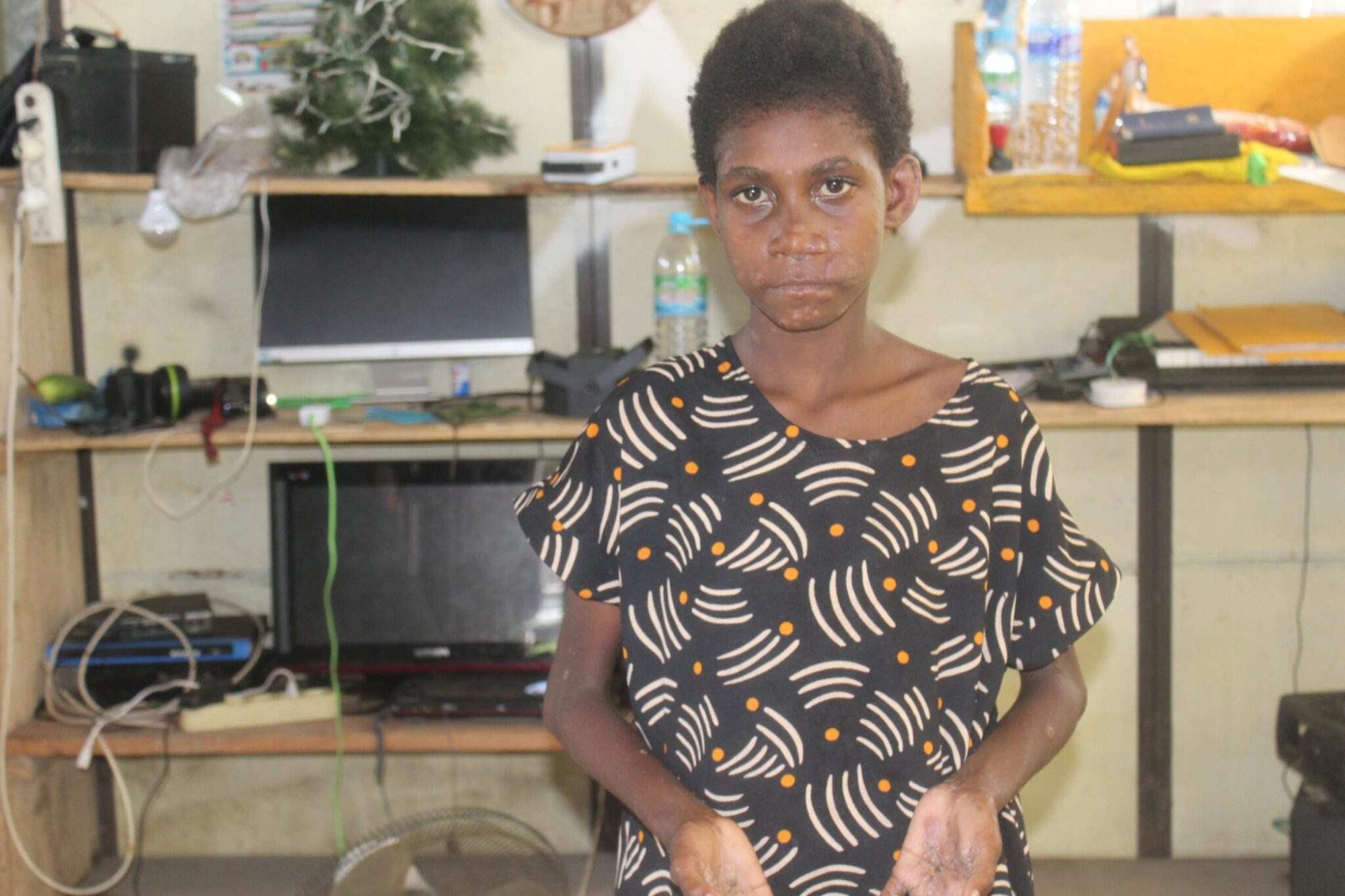
Bas Karewa faced a similar situation. Agustina Bipora, Bas’s parent, acknowledged that the symptoms arose after her son bathed in the sea near the village.
“I took him to the local health center for treatment. The health worker prescribed antibiotics,” Agustina stated.
Ananias Kawera, a student at Taruna Nautical High School in Mimika, also suffered from skin diseases on his hands, thighs, and legs. Kawera revealed that the itching began after bathing in the sea.
“After bathing in the sea, I returned home feeling itchy and experienced swelling. The itching intensifies at night,” Kawera explained.
Polce Irahewa, a 30-year-old health worker at the health center in Ohotya, suspects that the itching is a result of an unclean environment. She has been treating approximately 30 children with similar skin conditions since December 2022.
The adverse effect has been felt for too long
Hanro Yonathan Lekitoo, an anthropology lecturer at Cenderawasih,said the Sempan indigenous community in Ohotya was an integral part of the larger Kamoro indigenous community. According to Lekitoo, despite minor language differences, they share the same clan and livelihood patterns. Their way of life centers around gathering, fishing, and relying on the three key elements of “river,” “canoe,” and “sago.” This lifestyle remains prevalent in Otakwa, similar to the Kamoro community in Timika.
Cyprianus Operawiri, the deputy II of the Kamoro Indigenous People’s Institute (Lemasko), revealed that in the past, the indigenous people from Ohotya, Umuga, and Inoga, who originally inhabited the area now known as the Far East Mimika District, were relocated to Timika, the capital of Mimika.
“The indigenous people from the Far East Mimika, including Otakwa or Ohotya, Umuga, and Inoga, were resettled in Timika together with the indigenous people from Koperapko, Nawaripi, and Negeripi villages.
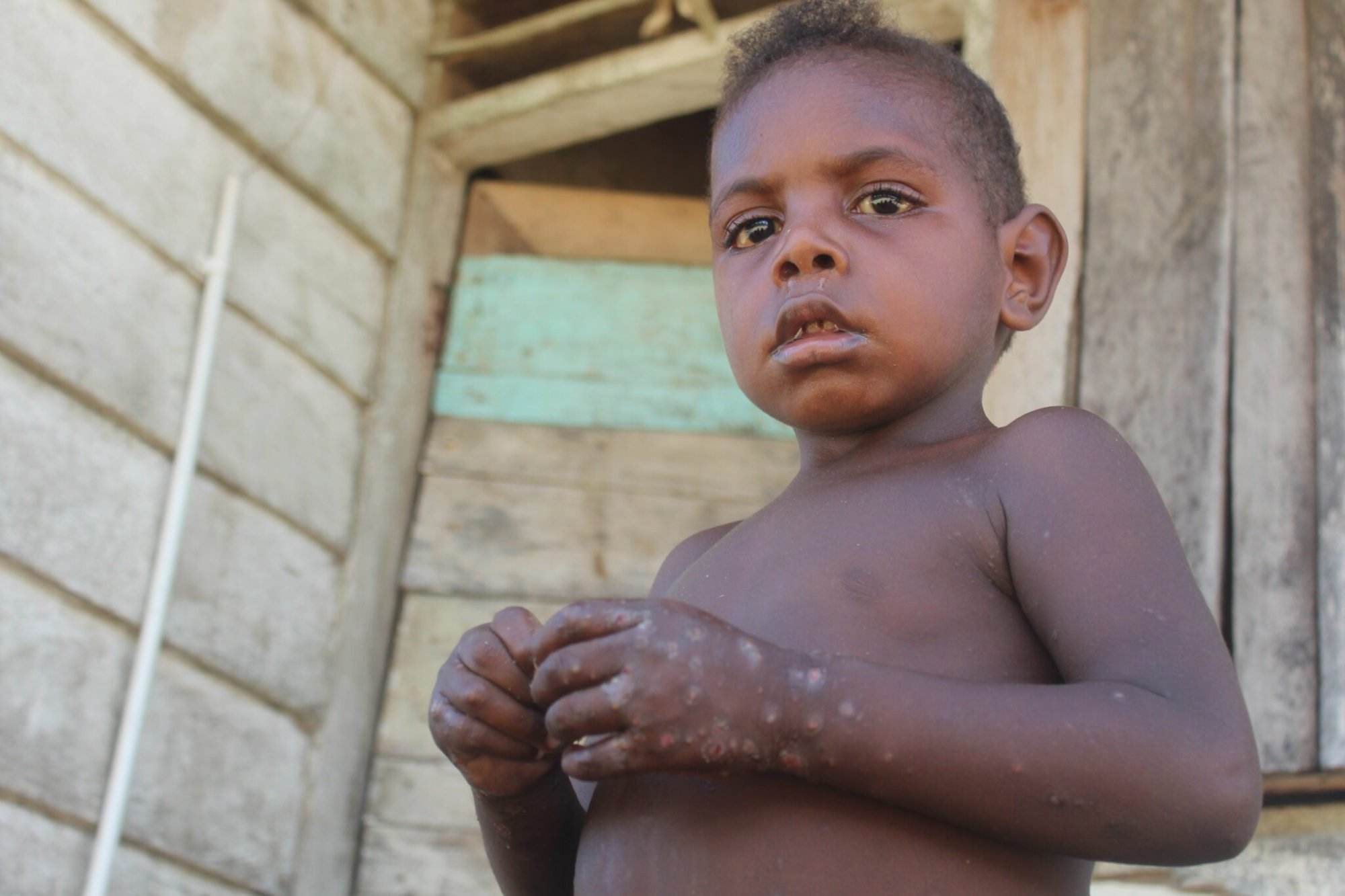
The Kamoro and Sempan indigenous communities have faced long-standing challenges due to the sedimentation of Freeport’s tailings. According to Operawiri, one affected area is the Old Koperapoka region, spanning from Kali Kopi in Kuala Kencana District to the coastal area of Koperapoka Beach.
In the past, this area was home to two villages, Waunaripi and Negeripi. However, due to security issues, the residents of these villages relocated to Pasir Hitam between 1977 and 1980.
In 1981, the Mimika Administration and Freeport initiated the relocation of 900 families from Pasir Hitam to another area because of the impact of tailings. The government and Freeport conducted analyses on the future consequences, such as siltation and the infringement of customary rights caused by Freeport’s mining activities.
After the relocation to Timika, the villages of Waunaripi and Negeripi were merged into a single village called Koperapoka. In 1993, the remaining residents of the old Koperapoka village were also relocated, resulting in the division of the new Koperapoka village into three separate villages: Nawaripi, Nayaro, and Koperapoka.
During the relocation process, Freeport provided housing and economic assistance through the Recognition Today, the residents of the three villages continue to reside in Timika, said Operawiri.
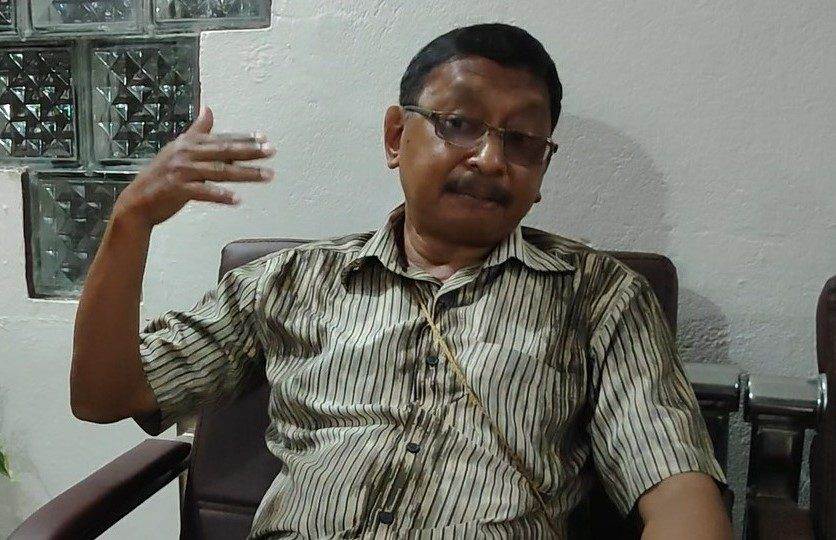
However, despite living in the new settlement for three decades, the Kamoro people have not experienced prosperity. Operawiri emphasized that the damage caused by tailings sedimentation in the watershed and coastal areas of Mimika began in 1991.
According to him, the forests that sustained the Kamoro indigenous communities were destroyed by the tailings. As a result, the community lost their hunting grounds, and the once-navigable river paths, such as the Amaufuruo, Muamiua, and Ayua Rivers, became shallow and filled with tailings sediment. The Amaufuruo River has even been blocked due to the deposition of tailings.
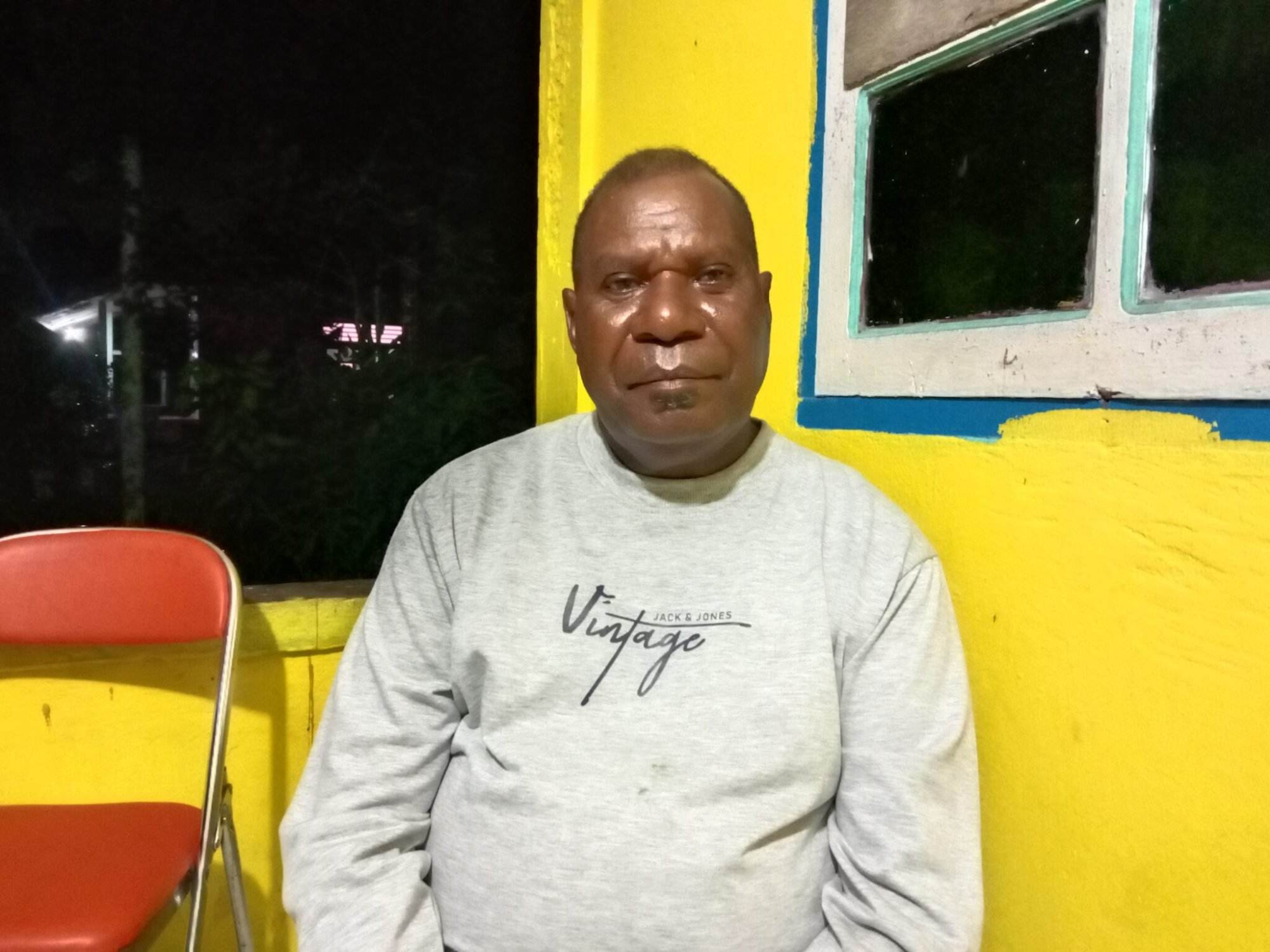
Additionally, the presence of tailings has led to the disappearance of several fish species, including stingrays, mangiwang fish, and snails. It has also deprived the indigenous community of access to clean water.
“The fish are no longer suitable for consumption, and the water that our parents used to collect from the river is now undrinkable. These are the direct impacts of Freeport’s tailings,” Operawiri said
He further confirmed that the sago hamlets, particularly in Nawaripi village, have been destroyed by the tailings. The challenge lies in the fact that each indigenous clan are tied to their specific customary land, and they cannot freely access natural resources from the land belonging to other clans. As a result, the indigenous people in Nawaripi Village are now compelled to purchase sago from the market.
“The Nawaripi community no longer has their own sago hamlets. Each clan has its own sago hamlet, and other clans cannot utilize sago from hamlets belonging to other clans”.
Operawiri expressed his sadness over the fact that the younger generation of Kamoro can no longer construct traditional long-paddle boats. They have lost the skills for hunting and processing sago, which involves extracting starch from the flesh of sago stalks.
“Nowadays, the young people no longer have the ability or knowledge to build boats. They can’t make the traditional spoon boats anymore”.
Adolfina Kuum, the coordinator of the Environmental Care Community (Lepemawi) in Timika, highlighted how thousands of fish died suddenly at Amamapare Port in Far East Mimika in 2016 and 2020, which raised concerns among the community.
“The community is becoming more proactive and discussing these issues. We anticipate that the challenges will become even more difficult for us in the next 20 years,” she added.
Expanding sedimentation
Gradually, the sedimentation of tailings from Freeport is spreading across the lowland and coastal areas of Mimika Regency. During a hearing with Commission IV of the House of Representatives on September 27, 2022, Tony Wenas, the President Director of PT Freeport Indonesia, claimed that the processing of gold, silver, and copper ore extracted from the Grasberg mine does not involve the use of toxic substances like mercury or cyanide. However, Tony acknowledged that the amount of tailings discharged is extremely large, exceeding 200,000 tons per day.
“The mining operations in the Grasberg open-pit mine were completed in 2019. During the processing of ore extracted from the open-pit mine, the non-economically valuable rock layers need to be removed before extracting the ore containing valuable minerals. In the case of underground mining, the ore containing valuable minerals is directly extracted so there is no impact of overburden, hence no tailings are produced,” Tony explained.
According to Tony, the processing of rocks obtained from the Grasberg open-pit mine involves physical methods that utilize reagents similar to alcohol. These reagents are employed to separate gold, silver, and copper minerals from the rocks that lack economic value.
“The remaining 97 percent, which consists of worthless rocks, is transported through the river system as permitted and deposited in a low-lying area known as the Ajkwa deposition area,” Wenas explained..
These various licenses serve as the foundation for PT Freeport Indonesia to dispose of tailings in the watershed and coastal areas of Mimika. Despite Freeport’s claim that open-pit mining in Grasberg has ceased and underground mining does not produce tailings, the volume of tailings in the highland deposition area remains substantial, leading to an ongoing increase in tailings sedimentation in the lowlands and along the coast of Mimika.
According to Sita Manessa, a Remote Sensing Expert from the University of Indonesia, tailings sedimentation has been widespread since the 2000s. Through observations of coastal areas and major rivers in Mimika, it has been noted that the process of siltation and sedimentation has gradually persisted since 1990 but has intensified from 2000 onwards.
Arnoldus Natikapereau, the head of Atuka Village in Central Mimika District, revealed that his area has been impacted by Freeport’s tailings since 2000, resulting in the shallowing of rivers. According to him, the Atuka River, which previously had a depth of 30-50 meters, now measures only 10-15 meters deep.

Natikapereau emphasized that the shallowness of the river has resulted in the inability to accommodate the tidal water discharge from the Arafuru Sea. Consequently, settlements along the riverbanks facing the Arafuru Sea, such as the Atuka Village, are frequently submerged by the tides.
“Atuka and Amar villages are particularly affected. Many houses have suffered damage due to the rising water levels, which caused the floors of the houses to elevate. In 2022, the situation worsened. One house was destroyed by the waves, and eight houses were severely damaged. The force of the waves hit the front of the houses,” Natikapereau explained.
Similar to the situation in Ohotya Village, the residents of Atuka Village, amounting to 373 individuals, have lost access to clean water. Previously, they relied on river water and well water for consumption. However, the well water has become discolored, rendering it suitable only for washing kitchen utensils, bathing, or doing laundry.
If rain does not arrive soon, the residents of Atuka have no choice but to resort to drinking river water or purchasing clean water from Pomako Port.
“We used to drink water from the river and well, but now it’s impossible. We can only hope for rainwater. We collect rainwater using reservoirs or tanks,” Natikapereau shared.
He further explained that the currents and direction of the coastal waves in the Arafuru Sea often change, leading to the destruction of previously safe settlement areas. The challenge lies in the fact that the indigenous people of Atuka can only relocate within their own customary land, all of which are vulnerable to waves with shifting directions.
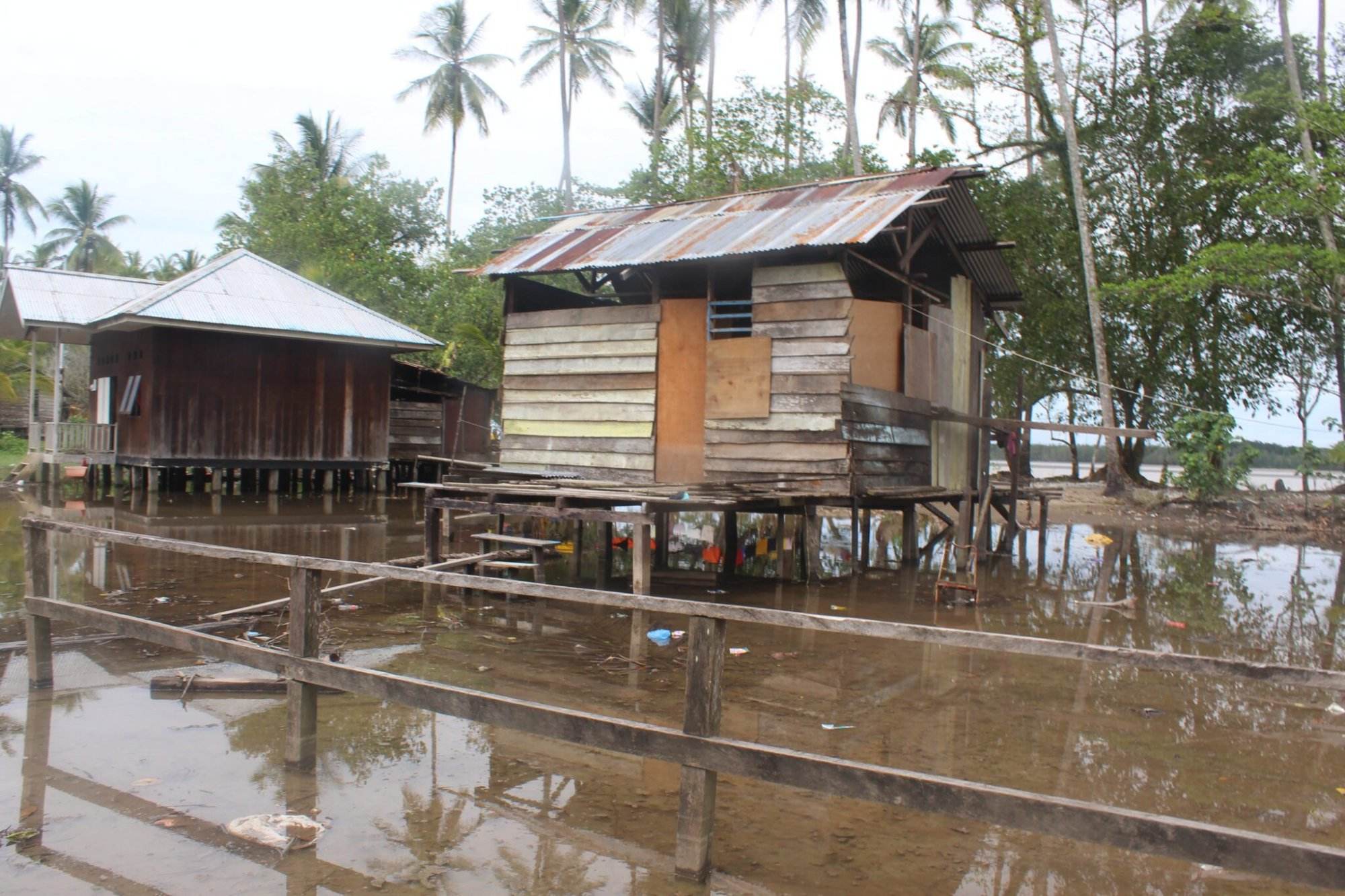
Natikapereau mentioned that Atuka Village is the eighth location where the Atuka community has settled. “According to the stories passed down by our parents, this is the eighth village. It is impossible for us to leave the village.We only migrate to the city in search of work, but one day we will definitely return to the village,” Natikapereau expressed.
Due to the siltation of the river along the Mimika coast, Atuka residents who need to travel by river must adjust their plans according to the tidal cycle. They have to embark on their journey at 7 a.m. because by 12 p.m., the river water recedes, causing the boat’s keel to get stuck, requiring the people to carry the boat due to the rising riverbed.
If they have to travel during the day, they are forced to take an alternative route along the bumpy coastal waters of the Arafuru Sea. However, very few people dare to take this route as most individuals only possess boats equipped with small horsepower engines.
“Even though we are people who live by the coast, we don’t dare to travel by sea. We rely on the river instead. We follow the high tide to travel. If the water has receded, we cannot pass at all. When we disembark from the boat, the water level reaches our chests. We simply hold on and wait for the tide to rise again so that we can continue our journey,” he explained.
According to Arnoldus Natikapereau, these difficulties are not limited to Atuka residents. “Everywhere, especially in coastal Mimika, [the situation is] almost the same. I don’t know in 10 or 20 years what will happen to our children,” he said.
Vulnerable indigenous communities
Hanro Yonathan Lekitoo said the close relationship between the indigenous communities and nature makes the communities more vulnerable to even slight changes in the environment. Therefore, the mining activities of Freeport, which have altered the natural conditions along the coast, have had a profound impact on the lives and livelihoods of the Kamoro and Sempan indigenous people.
Additionally, the mangroves, which play an essential role in their ecosystem, have also been lost. As a result, the Kamoro people are facing significant challenges in their daily lives.
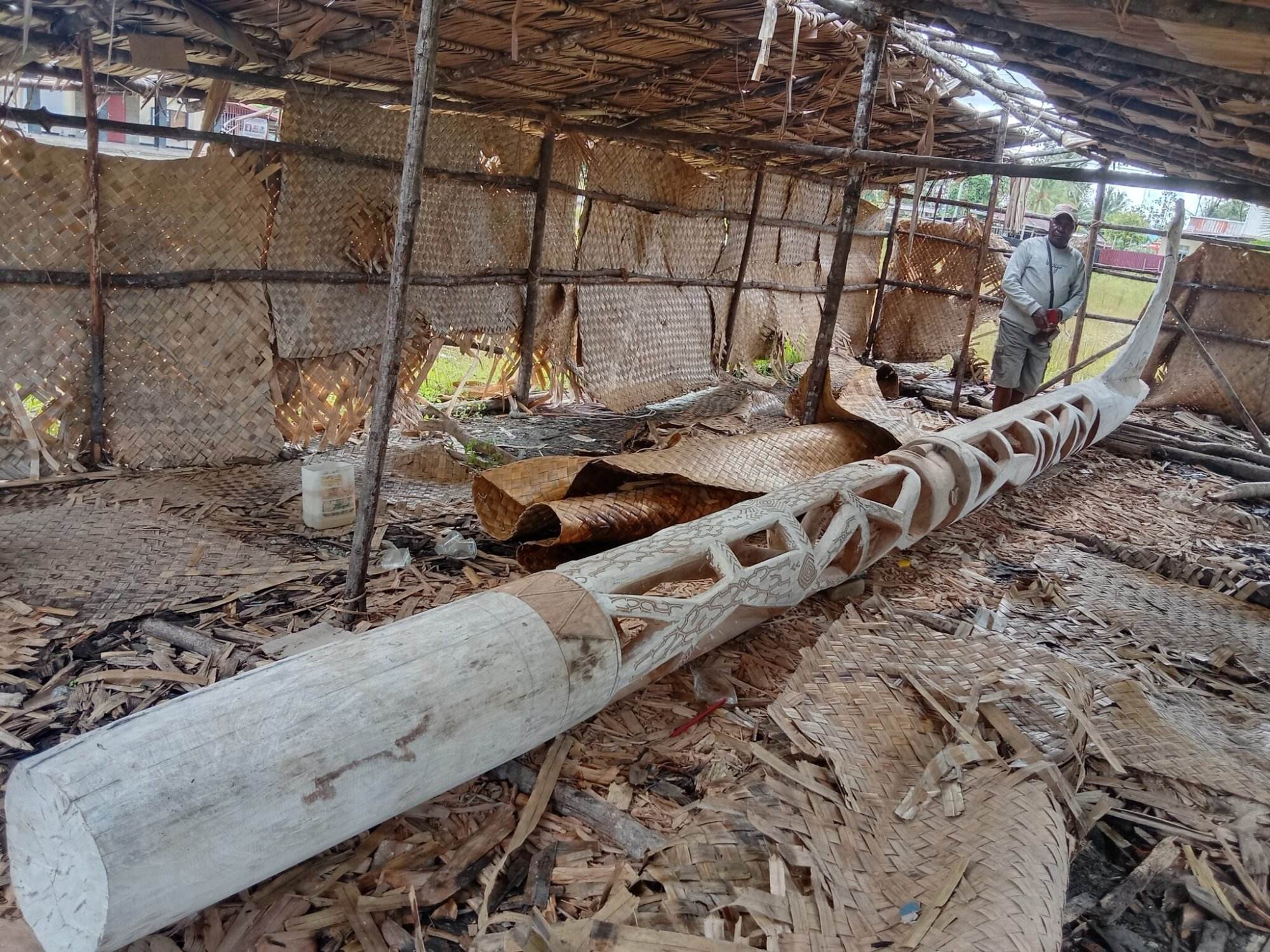
Lekitoo mentioned the traditional cycle of living followed by indigenous communities, known as kapiri. Kapiri involves the community temporarily leaving their homes and residing in the forest or watershed for several weeks to search for food and resources.
The Kamoro indigenous people adhere to a subsistence economy system, where their focus is primarily on finding enough food for the present day. Lekitoo explained that their daily life revolves around seeking sustenance for the current day and repeating the process the next day. They engage in activities such as fishing in the river and selling their catch at the market, with their primary aim being the sufficiency of their daily needs rather than accumulating wealth.
Lekitoo highlighted the vital role of rivers for the indigenous communities along the coastal areas. In a research study conducted by Lekitoo and his team between September and October 2016, they examined the utilization of the Okoroppa River by the Kamoro indigenous people. The research was prompted by Freeport’s plan to close off the Okoroppa River.
During the study, Lekitoo’s team observed and monitored the community’s activities in the Okoroppa River from 9 a.m. to 2 p.m. for a month. They documented the number of individuals crossing the Okoroppa River for purposes such as fishing, trade, visiting relatives, attending school, and seeking medical assistance.

Kelen
Lekitoo revealed that within a span of less than three weeks, nearly 1,000 individuals used the river as a means of transportation. This count does not include the river users after 2 p.m. until nighttime. Additionally, many people rely on the river during the night due to the tidal conditions. Lekitoo mentioned that some individuals even make stops at Amamapare Village on Karaka Island.
According to Lekitoo, the research findings were presented to Freeport’s management. He emphasized that the community strongly opposes the closure of the river, as it is the sole access point for the Kamoro people to reach Pomako, particularly those coming from the Far East Mimika region.
Lekitoo highlighted the issue of multiple river closures due to the detrimental impact of Freeport’s tailings disposal. Specifically, the Amapiraripi, Amawuraro, Tawaiwo, and Yaimaima Rivers have been affected. The Kamoro people have suffered the loss of their primary food sources, including sago, fish, crabs, and shrimp, as a result of the tailings. These natural resources are crucial for their livelihood.
Observing the severe impact on the Kamoro people’s traditional food sources, Lekitoo expressed concerns about the future of the indigenous people. With the loss of their essential natural resources, their dependence and well-being are uncertain.
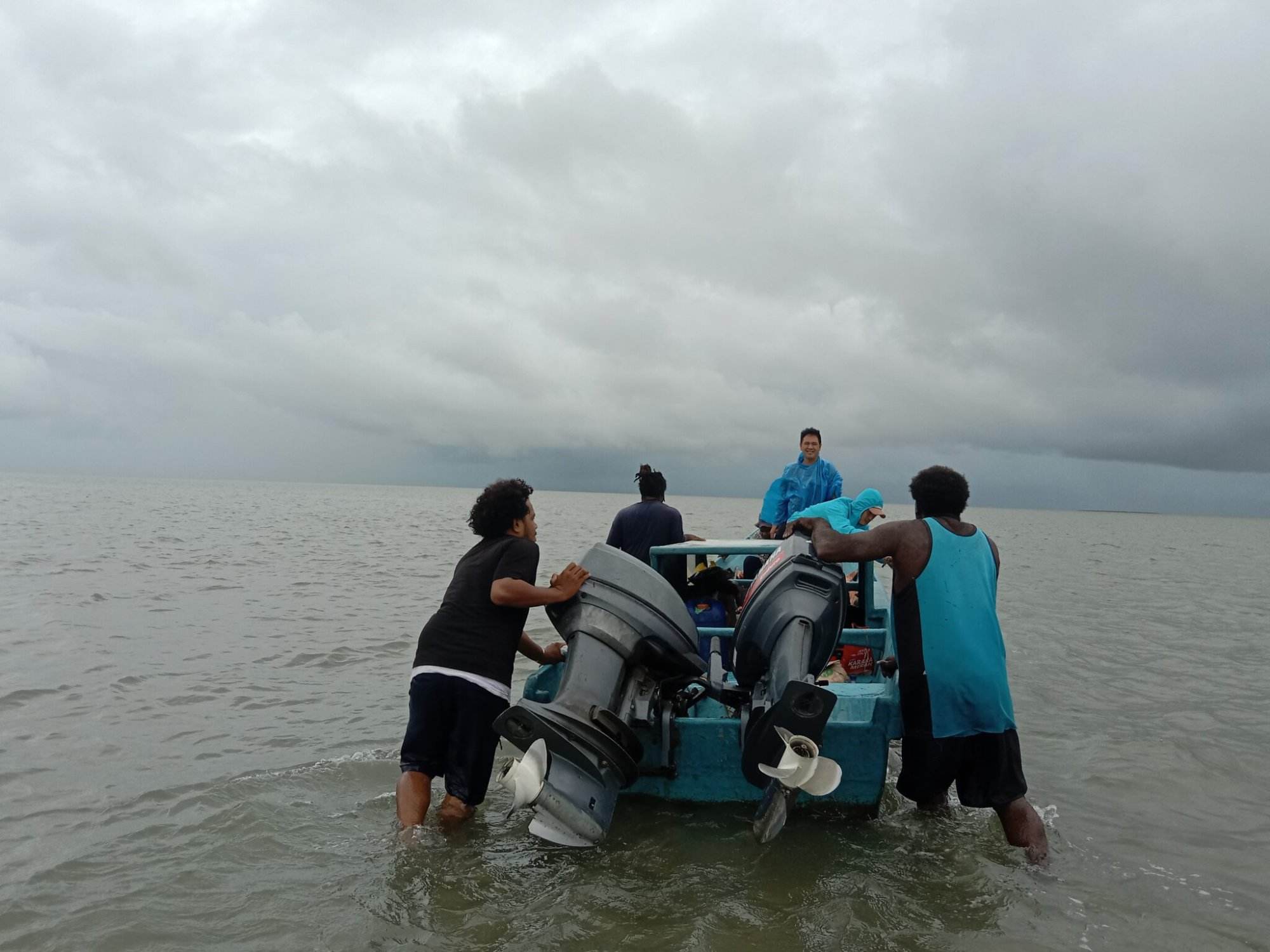
Lekitoo explained the crucial role of the Okoroppa River as the heart of the Kamoro people’s sustenance. He likened it to being their kitchen, supermarket, and food barn. If the Okoroppa River, the last remaining accessible river, were to be closed, it would be equivalent to shutting down their vital sources of nourishment and essential resources. Lekitoo expressed concern as he mentioned that four rivers have already been closed, leaving Okoroppa as the last hope, which may also face closure.
Furthermore, Lekitoo highlighted that the issue of tailings not only affects the river systems but also impacts the Arafura Sea, which is currently experiencing siltation. This problem extends beyond the rivers and affects all forms of sea transportation that rely on the area.
This situation poses a challenge for motorboat operators and passengers who often encounter shallow areas. In such instances, they are forced to physically push the boat to keep it moving. Sometimes they have to wait for the water level to rise before the boat can proceed with its journey.
Failed social investment
PT Freeport Indonesia has provided substantial assistance to indigenous communities affected by its mining operations. According to the Environmental Impact Assessment (ANDAL) document titled “Development and Optimization Plan for Copper and Gold Mine of 300,000 Tonnes of Grain/day by 2022,” Freeport disclosed that it has disbursed hundreds of millions of dollars for community empowerment initiatives.
The document outlines that in 2021, the company allocated a total of Rp1,564 trillion (US$ 109.3 million) for social investments. These social investments are categorized into various funds, including Partnership Funds amounting to Rp 1,075 trillion, Trust Funds amounting to Rp 21,462 billion, and various special projects receiving Rp 34,339 billion in funding.
Furthermore, the social investment funds were utilized for other divisions within PT Freeport Indonesia, totalingRp 48,647 billion, as well as the PTFI contribution committee, which received Rp12,267 billion.

Social investment funds are utilized for various social programs that span across the areas surrounding Freeport. These programs benefit both highland villages such as Waa Banti, Aroanap, and Tsinga, as well as lowland villages including Tipuka, Ayuka, Nawaripi, Nayaro, and Koperapoka. Coastal villages like Fanamo, Omawita, and Ohotya also receive support through Freeport’s social investment initiatives.
According to the same document, Freeport and the Amungme and Kamoro Community Development Foundation (YPMAK) have made significant financial contributions to the Amungme Indigenous Peoples Organization (Lemasa) and Kamoro Indigenous Peoples Organization (Lemasko).
From 2000 to 2019, PTFI contributed US$ 3 million to Lemasa, while YPMAK provided US$ 15.1 million from 2003 to 2019. In October 2020, Freeport further extended operational funding support of Rp 15 billion per year to Lemasa.

Similarly, between 2005 and 2019, Freeport made financial contributions of US$ 300,000 to Lemasko, while YPMAK contributed US$ 17.4 million from 2003 to 2019. In October 2020, Freeport once again provided operational funding support of Rp 15 billion per year to Lemasko.
Meanwhile, Hanro Yonathan Lekitoo believes that the community empowerment program run by Freeport and YPMAK has not brought significant changes to the community.
“The community does not seem to have experienced significant changes. We can count how many Kamoro people are economically capable in the Timika area today,” said Lekitoo.
According to Lekitto, there must be social, educational, and economic engineering so that the Kamoro people can move from a gathering lifestyle to a sedentary lifestyle, so that they can adapt to the impact of changes in the Mimika coastal environment.
“They live in the same position as 50 years ago. Walking from the river to the market, to the city, and back to the river. With a pattern that has not changed, with a standard of living that has not changed,” he said.
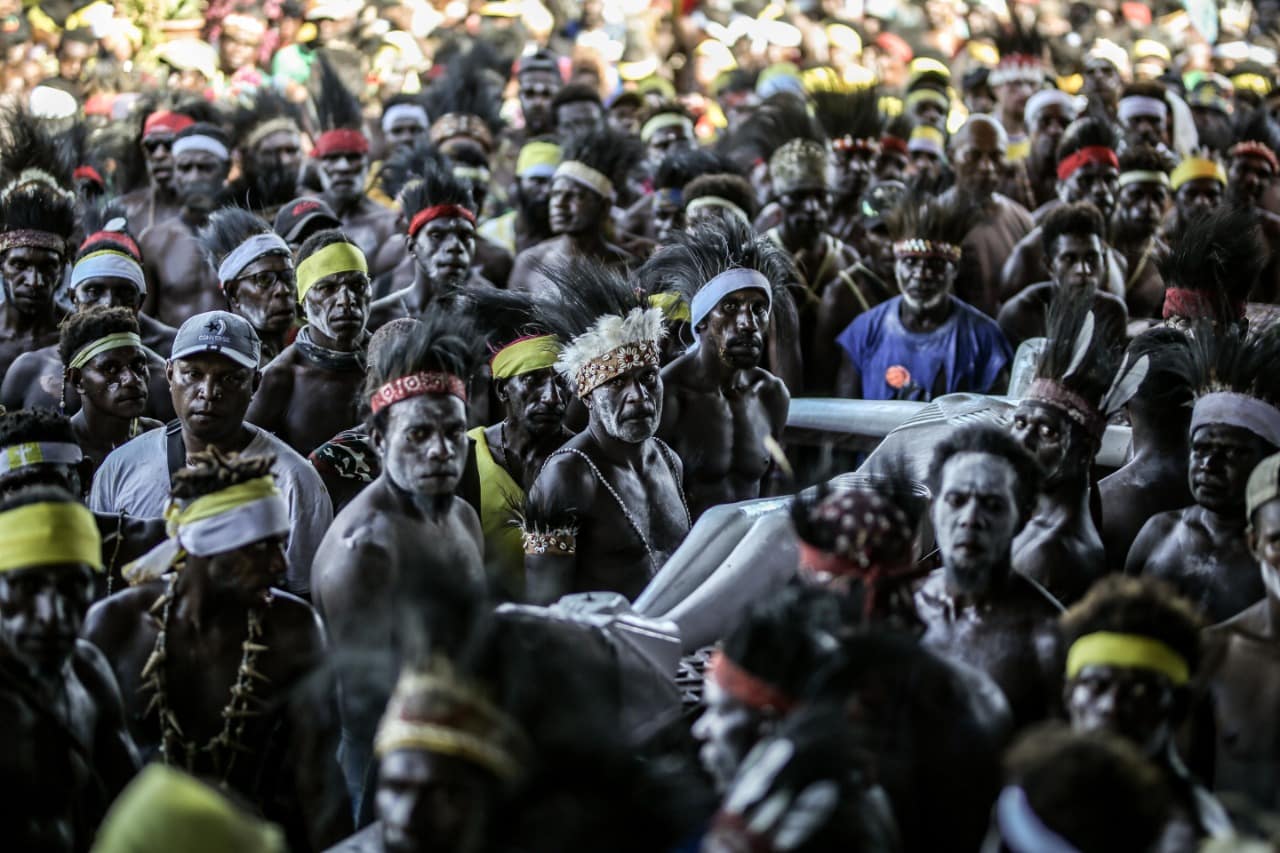
Lekitoo said the cycles and patterns of kapiri life – when indigenous people leave settlements to live in bivouacs and hunt for weeks in watersheds or forests – make indigenous Kamoro communal and not oriented towards accumulating capital. Their social safety net is togetherness with others, sharing and accepting each other.
Consequently, indigenous people find it challenging to thrive within the contemporary, highly individualistic economic system. In contrast, the mining activities of Freeport have caused a massive influx of migrants from various parts of Indonesia to Timika, who now dominate the formal and informal sectors of Mimika’s economy.
“Indigenous people live in communal settings, focusing on meeting their immediate needs. This significantly affects their ability to compete in a modern or capitalist system. The migrants who have arrived now control the economy, while the Kamoro people primarily engage in selling their goods at the river market,” explained Lekitoo.
Lekitoo further highlighted that the socio-economic lifestyle of Papuans, such as the Kamoro, does not revolve around hoarding for personal profit. Instead, their community is built upon maintaining harmony with the surrounding nature and each other. However, this valuable wisdom leads to their marginalization within an individualistic modern economic system that emphasizes profit-seeking and capital accumulation.
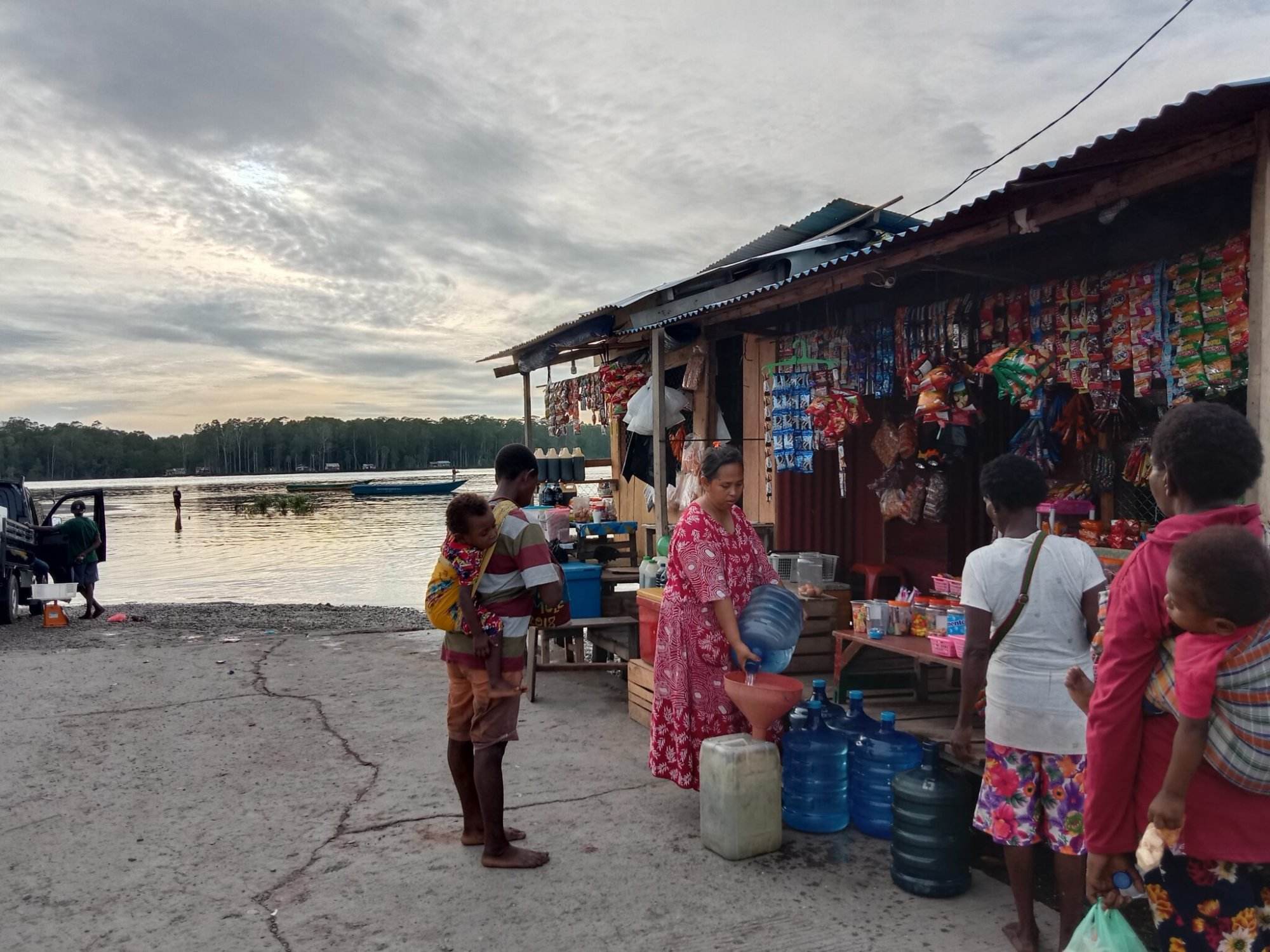
“This presents a major challenge. Yet, it can be addressed through social and educational interventions. For decades, we have struggled to transform a society with a deeply ingrained lifestyle, using the current education model. We need to organize educational programs that empower the younger generation, steering them away from solely following their parents’ path,” he concluded.
Lekitoo expressed the need for an evaluation of the long-standing empowerment efforts carried out by PT Freeport Indonesia and YPMAK, as they have not successfully helped the Kamoro indigenous people transition from their hunting and gathering lifestyle.
He highlighted that YPMAK should take responsibility for conducting this evaluation. Lekitoo pointed out that despite the substantial amount of financial resources invested, only one Kamoro individual, Leonardus Tumuka, has achieved a doctorate degree. He questioned why, with such significant funding, there has not been the creation of 30 to 100 doctors within the community.
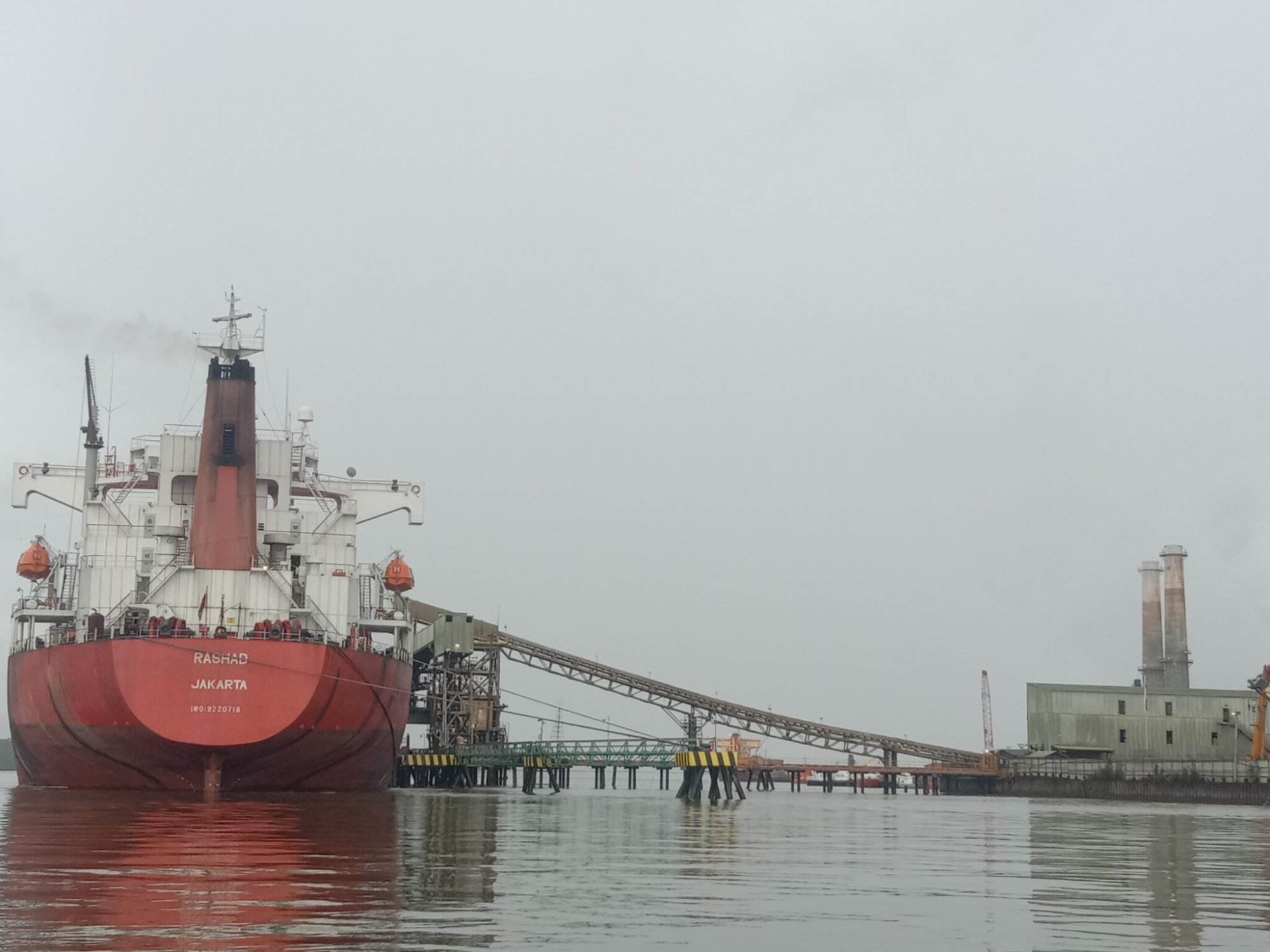
Meanwhile, Maria Fransisca Mitapo, the head of the Environmental Law Enforcement Section of the Mimika Environmental Agency, acknowledged that Freeport’s tailings have contributed to river siltation and ecosystem damage. However, she stated that there have been no findings indicating that the tailings sediment has caused pollution in the water or marine biota along the coastal areas of Mimika.
“When we observe with the naked eye, we can see the siltation of rivers that are used for transportation and the livelihoods of coastal communities. The finest sediment settles at the estuary, while the rest flows into the Arafura Sea. However, there have been no findings of fish contaminated with tailings or causing health damage. Such cases do not exist yet,” Mitapo explained.
Mitapo mentioned that restoring the rivers and their ecosystems would be challenging as long as Freeport is still in operation. She stated that the recovery process could take place after Freeport ceases its operations.
“The ecosystem is inevitably disrupted due to the ongoing operations. Restoration will take place after the operations end. Currently, it is not possible because the operations are still ongoing, which leads to the occurrence of damages,” she stated.
Cyprianus Operawiri called on the Mimika Administration and PT Freeport Indonesia to address the issues faced by indigenous communities affected by the tailings of Freeport. Operawiri expressed his concern that both the government and the company seem to be ignoring the situation, despite the increasing impact of the tailings.
“They are already aware of the communities that hold the affected customary rights. Freeport and the government are well aware. It is essential for them to open their eyes and visit the villages directly affected, to witness the areas that have suffered damage firsthand,” said Operawiri. (*)


